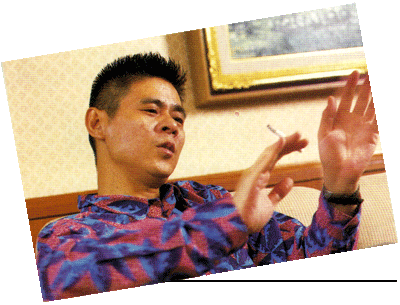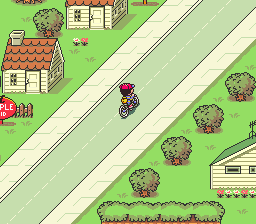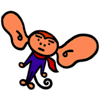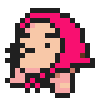Weekly Famitsu – September 2nd, 1994
by: 8lackSphinx on 4/20/2020
Weekly Famitsu: First of all, it’s been quite a while since your last game. How has it been in the meantime? Pretty tough, I’m sure.
Itoi: Yeah, it’s been absolutely rough. [laughs] Honestly, at one point I thought we’d hit a brick wall. I’d even get wisecracked about it when I went to baseball games. I had kids sitting around me telling me, “MOTHER 2 isn’t coming out, is it? I mean, you’re here watching baseball.” It’d reached the point where even I was the one spending my nights sleeping on three lined-up chairs. [laughs]

Weekly Famitsu: Did you face any battles with the memory capacity?
Itoi: M1 was three megabits, and M2 started off at eight megabits. We realized that eight megabits didn’t quite fit our demands, but we wondered if twelve would even be enough. The issues with space were settled as the ROM performance improved, though.
Weekly Famitsu: What was the most difficult thing you faced?
Itoi: The graphics gave us a hard time. It took some seriously fine craftsmanship to connect the entire map with that diagonal birds-eye view style. Like staying frugal while also taking some big chances. But the graphics took five years to work on, which might have ended up being a good thing. We started working on the graphics from the very beginning of production, and managed to finish them by the end.
Weekly Famitsu: The music is amazing. Is some of your own taste in music mixed in?
Itoi: The people who worked on the music have much broader tastes than I do, although it’s more “disorderly” than broad. [laughs] We’d like something we heard, and before we knew it the sound was taking up eight megabits. [laughs] That would take about two CDs to release on a soundtrack. But I’m proud of it. I don’t want anyone complaining about the music.
Weekly Famitsu: I was impressed with the guitar vibrato when I fought the hippie in the last game.
Itoi: I think that was the first time there’s been string-bending in video game music. This time there’s fretless bass in it, and more songs that are a bit on the jazzy side.
Weekly Famitsu: How about the battle backgrounds?
Itoi: It’s a Video Relaxant. [laughs] The guy who worked on the battle backgrounds was sort of a backgrounds otaku. Took two whole years. Apparently there are about 200 different kinds. [laughs]
Weekly Famitsu: This time around, the game takes place all over the world; did you have that in mind from the beginning?
Itoi: When M1 was completed, I wanted to take things into outer space. I’ll go ahead and mention this because it has nothing to do with M3, but I was even thinking about including interstellar travel. That would actually make the story more cliché, though, so I decided against making a spectacle out of it. When I play RPGs, I can’t help but feel like the screen is stuck on the same static image the entire time. It’s not as attractive as a cartoon — the scenery doesn’t even change. I didn’t like that, so I wanted to make a game that involved traveling all over the place and enjoying different kinds of sights along the way.
Weekly Famitsu: And that’s where the global aspect comes in. So were you quick to abandon the outer space idea?
Itoi: No, I put a lot of thought into it. I mulled it over for maybe three, four months.
Weekly Famitsu: Which town in the game is your personal favorite?
Itoi: Before the game was finished, it was Summers. We called it Côte d’Jours when we made it, since it was a summer resort. But now I like the towns that are the toughest to get through. The ones that have a lot of twists and turns in them are so much fun. Threed’s a dark town, but it’s full of memories.
Weekly Famitsu: The townspeople have really distinct faces, and everyone’s different.
Itoi: Well, it’d be disappointing to see people with the exact same face. In the end, I didn’t want to make this a game simplified by symbols. When you’re in the overworld and you have to walk into a symbol to trigger the screen and open up the town, that town ends up being turned into that icon. And I especially wanted to avoid representing people through mere symbols.
Weekly Famitsu: By the way, during battle scenes, there’s that new rolling HP meter — like a slot machine. Was that decided on from the beginning?

Itoi: For the first six months or so I had something else in mind for the battle system. It was going to be made of pachinko beads. This was right when a pachinko parlor opened up next to our office and everyone was really into it. [laughs] When the pachinko beads fall out of a tray on top, it sort of gives that feeling of life wearing thin, doesn’t it? I wondered if there was some way to represent HP and stuff through those little beads. It’d be scary to see this stream of beads only rattling out from your own party, wouldn’t it? The catch was how difficult it became to portray it on-screen as the amount increased — it ended up covering a whole third of the screen. We tried moving on with it as-is, but I knew at that rate that things were going to get ugly.
Weekly Famitsu: And that’s how it moved from pachinko to slots…
Itoi: Actually, it’s more like a meter for gasoline. The numbers kind of drop downward, right? That dropping sensation is kind of unnerving. Analog is different from digital — watching the numbers dwindle one after another is scary.
Weekly Famitsu: Plus it helps to be able to hurry and restore your HP before the meter’s done spinning.
Itoi: That becomes evident once your HP reaches triple digits. I’m glad I figured it out early on.
Weekly Famitsu: When was that?
Itoi: ‘bout four years ago. [laughs]
Weekly Famitsu: That was already decided on four years ago? [laughs]
Weekly Famitsu: Was anything else changed halfway through production?
Itoi: The controls for the bicycle changed. It used to be like remote controls [must stop to turn], but now the controls work the same as when you walk.

Weekly Famitsu: When I played earlier, it was still using the old controls, then…
Itoi: When the slogan ended up having “even older sisters” in it, we decided to keep it simple. Actually, a big reason for the control change was that I couldn’t ride it. [laughs] We toured the country to attend briefings with wholesalers and ended up lying when we said, “The bicycle works like a remote control!” [laughs]
Weekly Famitsu: We’ll be sure to follow through on our articles and clarify that it used to be remote control. [laughs]
Itoi: Terribly sorry. [laughs]
Weekly Famitsu: Now, are you the one who came up with the “Don’t Care” names?
Itoi: I tried getting my employees to come up with some names, but all I got was stuff like “Shamisen” and “Heebie-Jeebies”. There were about thirty or forty suggestions, but they were a mess so I ended up writing most of them myself, to keep it safe. If names in RPGs aren’t innocent, it turns into a real comedy, you know? If I get the message “Pantyless has died” on my screen, I’d feel pitiful, like, what the heck am I doing? [laughs]
Weekly Famitsu: How about that you-know-what that shows up in the credit roll at the end of the last game?
Itoi: I included it again. Actually, this time it’s not only in the ending — there’s a point when the player’s name greatly influences the gameplay, too. So it’s a good idea to avoid using any old screwy name.
Weekly Famitsu: I was really moved when I saw my own name show up last time.
Itoi: It feels good, doesn’t it? After all, my original inspiration for making a video game was a desire to include my own name in it.
Weekly Famitsu: Do you have a message for M2 players?
Itoi: Back then, my older sister—who was even more of an amateur—played the game. But lately, girls don’t play games. Nowadays people are starting to think of video games as uncool. People who play pick-up basketball games and rap just don’t play games, you know. At this rate, gaming is going to turn into something limited to nerdy conventions and stuff. So I want the older sisters of the world to come back to playing video games. But kids, on the other hand, I’d rather scold about playing too many video games. [laughs] The Famicom is fun, but it’s about at the level of a TV show. When all is said and done, it’s the people who are funny. It’s not like there’s a person out there who is limited to twenty-four megabits. There are billion-megabit people just idling around. Experiencing outrageous things outside, having adventures — it’s fun because people like that play the Famicom. I’d like to make a game that those people can enjoy.
Weekly Famitsu: By the way, how is M3 coming along?
Itoi: It might take two more years, and it could end up on a next-generation machine. I don’t know about M3, but I think M2 is just fine. I mean, it did satisfy Nintendo’s own Miyamoto. He was saying how it’s the first RPG he’s ever beaten.
Weekly Famitsu: That’s amazing. [laughs] I look forward to playing the new release. Thanks so much!
















